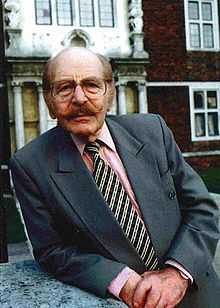Maurice Grosse
| Maurice Grosse | |
|---|---|
 | |
| Born |
Maurice Grosse March 6, 1919 london, England, UK. |
| Died |
October 14, 2006 (aged 87) United Kingdom |
| Occupation | Paranormal investigator and painter |
| Organization | Society for Psychic Research |
| Religion | Jewish |
Maurice Grosse (6 March 1919 in London, England – 14 October 2006 in London, England) was a British paranormal investigator famous for his involvement in the Enfield Poltergeist case.
Early life
Grosse was educated at the Regent Street Polytechnic in London. After serving an apprenticeship in commercial art and design, he served in World War II with the Royal Artillery and was among those evacuated from Dunkirk in 1940. Commissioned in 1941, he became responsible for the guarding and welfare of Italian prisoners of war for the remainder of the war. He married his wife Betty Grosse in 1944 and they had two daughters and a son. After the war, he became an inventor, and he filed the first of his many mechanical patents in 1945. His most successful invention was the rotating advertising billboard. In 1961 Grosse founded his own design and engineering consultancy business which became responsible for launching many patents throughout the world.[1]
Psychical Investigator
A personal tragedy launched Grosse into psychical research, when his daughter Janet was killed in a motorbike accident in August 1976. Following her death, members of Grosse's family experienced a number of coincidences and psychic happenings. These led him to join the Society for Psychical Research and the Ghost Club. In September 1977 he investigated a poltergeist in a house in Green Street, Enfield, North London. This became the famous Enfield Poltergeist case. Grosse supported the family for many months, staying at the house for long periods and recording many hours of cassette and video evidence of the phenomena. The poltergeist activity is summarised in the book This House is Haunted (1980), written by Guy Lyon Playfair, who also investigated the case.
A controversial aspect of the case was a voice resembling that of an old man but speaking through an 11-year-old girl who was the focus of the poltergeist activity. When the girl was accused by ventriloquist Ray Alan and others of faking the voice, Grosse offered £1,000 to anyone who could duplicate the voice by ventriloquism or any other form of trickery. No one took up his challenge.[1]
The parapsychologist David Fontana in an article proposed that poltergeists could haunt tape recorders. He speculated that this may have happened to the Grosse who investigated the Enfield Poltergeist case. However, Tom Flynn a media expert for the Committee for Skeptical Inquiry examined Fontana's article and suggested an entirely naturalistic explanation for the phenomena. According to the skeptical investigator Joe Nickell "Occasionally, especially with older tape and under humid conditions, as the tape travels it can adhere to one of the guide posts. When this happens on a deck where both supply and take-up spindles are powered, the tape continues to feed, creating a fold. It was such a loop of tape, Flynn theorizes, that threaded its way amid the works of Grosse’s recorder."[2]
Later life
Grosse investigated many other cases, and served as a member of the Society for Psychical Research's Council, as well as being the long-serving Chairman of its Spontaneous Cases Committee. In 1995 Grosse was at a vigil in Charlton House when it was claimed that a piece of crockery materialised and shattered. In 2000 he again was able to record poltergeist knockings on videotape at the home of a family in north London. In addition to ghosts and poltergeists, Grosse also investigated numerous claims of precognition. He also put together an extensive collection of alleged examples of psychic photography. He continued this work right up until the summer of 2006.
Grosse appeared posthumously in Channel 4's documentary Interview with a Poltergeist which was transmitted on 6 March 2007. He also made an appearance on the Channel 4 mockumentary Da Ali G Show in which he was interviewed by Sacha Baron Cohen.
In 1998 Grosse sued David Baddiel for £10,000 after Baddiel had described a psychic investigator called Maurice Grosse who lives in High Barnet, North London, and runs away with a married woman.[3] This was in Baddiel's novel, Time for Bed. They settled out of court and Grosse gave his sizeable winnings to charity. After Grosse's death, in Baddiel's 2010 film, The Infidel he again introduced "Maurice Grosse, psychic investigator from High Barnet". This time the wife of Lenny Goldberg, played by Richard Schiff star of The West Wing, had left Goldberg for the character Grosse.
Family
Maurice Grosse married his wife Betty Grosse in 1944 and Maurice and Betty had two daughters and a son
| Name | Birth | Death | Issue | |
|---|---|---|---|---|
| Janet Grosse | 1954 | 1976 | (Age 22) | Unknown |
| Richard Grosse | 1952 (Age 63) | Alive | Unknown | |
References
- ↑ 1.0 1.1 Grosse's obituary in Fortean Times
- ↑ The Haunted Tape Recorder by Joe Nickell
- ↑ Article from The Daily Mail 15 December 1998